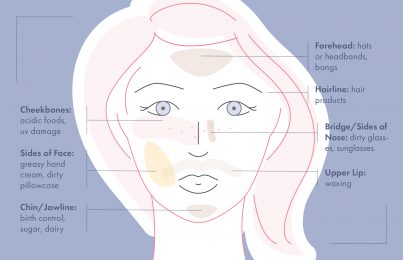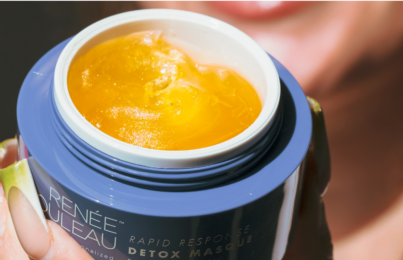If you struggle with stubborn, hormonal acne, you might already know about the supposed link between cystic breakouts and certain foods. One theory is that high-glycemic foods, such as sweets and white bread, can trigger hormonal breakouts by fueling the body’s inflammatory response (after all, acne is an inflammatory condition). Another theory is that dairy can trigger cystic acne. I’ve helped so many clients with persistent hormonal breakouts in my 30 years as an esthetician, and questions about dairy have come up again and again. The answer isn’t so simple—not all dairy is created equal, and research on the topic is a little sparse.
In this post, I’ll explain the link between dairy and cystic acne. I’ll also provide a game plan for what to do if you suspect dairy could be making your breakouts worse.
Why Hormonal Breakouts, and Why the Chin and Jawline Area?
When we talk about the possible link between dairy and breakouts, we’re specifically talking about hormonal (cystic) breakouts. Cystic blemishes are those hard, often painful, bumps that never come to a head. They just sit there and can seemingly take forever to go away.
It’s incredibly common to get hormonal breakouts on the chin and around the jawline. Hormones trigger oil glands, of which there are many in these areas. Since hormones are fat soluble, the body will use these glands as an avenue of excretion for fat-based hormones.
What is the Link Between Dairy and Hormonal Breakouts?
Experts hypothesize that, since the majority of milk comes from pregnant cows (and some cows in the U.S. are given additional growth hormones), the hormone levels in milk may play a role in excess sebum production, which promotes acne. In other words, the consumption of certain dairy products may influence the hormones that trigger oil production in the skin to ignite the breakout process.
It’s important to note that dairy is not the cause of hormonal breakouts. A combination of internal factors like genes and hormonal fluctuations is ultimately to blame. You’re either predisposed to acne, or you’re not. That said, external factors (like dairy) can definitely be triggers that make breakouts worse and more difficult to manage.
Got (Skim) Milk? Not All Dairy Products Are Created Equal
If you’ve been reading all this thinking, “But I can’t give up cheese!” I get you—and I have some good news! Although there isn’t a ton of research about the link between dairy and cystic breakouts, what we do have shows that only specific types of dairy seem to have an impact (statistically speaking). Specifically, milk is what continues to get called out. Even more specifically, the strongest link seems to be between skim milk and breakouts. Low-fat dairy in general is thought to be more likely to trigger breakouts than full-fat dairy products. (Cheese lovers, rejoice.)
Now, this isn’t to say that it’s impossible for full-fat dairy products to stimulate breakout activity. As I said, the research is sparse, and a lot of what we know is anecdotal. This is why it’s really important to experiment for yourself to try to get a sense of what does or doesn’t work for your skin.
What to Do If You Suspect Dairy Is Triggering Cystic Breakouts
If you suspect dairy could be an acne trigger for you, try cutting it out of your diet completely for three weeks to see if there’s any improvement. If you tend to get cystic breakouts around your cycle, start cutting out dairy as soon as your period ends to see if it impacts the next one.
Once you’ve established a baseline, try slowly adding in different types of dairy. Adding them in one at a time will make it easier to pinpoint if a certain type of dairy is more problematic for you than others. It can also give you a good sense of your personal tolerance. For instance, some people can consume moderate amounts of dairy without triggering their breakouts. Other people might be able to tolerate very little.
I know this process seems tedious, but if you’re dedicated to getting to the bottom of your hormonal breakouts, it’s worth it. My career as an esthetician has taught me that sometimes, anecdotal experience is the best. No two people are exactly alike. Research is a great tool to guide you, but it’s so it’s important to test things out for yourself.
Speaking of which, here are my other tips for dealing with hormonal breakouts. One of them is to spot-treat blemishes without drying out the rest of your skin, which can make breakouts worse. One of my favorite ways to do this is with the Chin Breakout Treatment Kit.
Remember That the Cause of Breakouts Is Incredibly Hard to Pinpoint
Finally, I want to leave you with a reminder that it’s difficult to isolate a single cause or trigger for breakouts. Acne is incredibly complex, and while I hope this post gets you closer to banishing yours for good, dairy is likely only one piece of the puzzle. I’ve mentioned in this post how powerful anecdotal information can be—here are 11 common causes of adult acne as I’ve observed them in my time as an esthetician.
Celebrity Esthetician & Skincare Expert
As an esthetician trained in cosmetic chemistry, Renée Rouleau has spent 35 years researching skin, educating her audience, and building an award-winning line of products. Her hands-on experience as an esthetician and trusted skin care expert has created a real-world solution — products that are formulated for nine different types of skin so your face will get exactly what it needs to look and feel its best. Trusted by celebrities, editors, bloggers, and skincare obsessives around the globe, her vast real-world knowledge and constant research are why Marie Claire calls her “the most passionate skin practitioner we know.”



Comments:
Do you have any other diet recommendations for skin improvement? I am 36 and tend to get hormonal flair ups. Mainly chin and jaw line, with cystic acne once a month. Cutting out dairy and increasing water intake have been listed. Any other recommendations? I just ordered the cystic acne treatment! Looking forward to battling these bumps!
Posted By: theresa |
Your best bet it to try cutting back on your dairy and using the Anti-Cyst Treatment both when you get cysts and used a few times a week on areas prone to getting them as a prevention measure.
Posted By: Renée Rouleau |
Hi, I suffered with cystic acne on my cheeks for 10 years!! I saw numerous doctors, tried anti-biotics, and the contraceptive pill..this helped a little, but didn’t eradicate the cysts completely..When one popped up it would stay there for 4 weeks, and when one went another would pop up on the other cheek…despite me leaving the alone they left scars. I got really fed up of them, I decided to try cutting out dairy, pretty much immediately my skin cleared up, no more cysts! I had some ice cream a few months ago and within 1 hour a cyst was coming up on my jawline! I will never eat dairy products again and wish I had found out years ago, could have saved myself a lot of scarring…why did no doctor suggest this?! I want to spread the word, people with cystic acne should try cutting out dairy before going on something like Accutane. So, just because the cysts are on your cheeks, not your chin/jawline, do not rule out dairy.
There are so many other calcium rich foods; soya, broccoli, nuts, eggs, beans, sardines. I think humans are actually the only mammals to drink milk after the age of 9 months..
Posted By: Layla |
Layla, do you still follow a dairy free diet? If so, are you acne-free?
Posted By: Jennifer |
I just purchased my second Anti-Cyst Treatment. I also posted a month ago about reducing my dairy to almost nothing. I still get bumps but they seem to heal quicker and not get quite as large. They are on my chin and I now have one between my eyebrows. My question: I feel like I can’t eat ANYTHING. Every pasta, snack food, salad dressing, ect has whey or some type of milk in it. Is this type of dairy product off limits for a clearer face. Milk is in everything! Thank you again,
Lisa
Posted By: Lisa |
Hi Lisa!
Great question. It’s important to really try to determine if dairy is the cause of the breakouts. So since you have cut it out, has your skin improved? If so, then it’s certainly a sign that dairy doesn’t agree with your skin. If you have not seen any improvement at all, then it’s more than likely a hormone issue and you can introduce dairy back into your diet. If you have seen improvement with your skin since cutting out dairy, then it means that you are sensitive to it but then it’s up to you to experiment to see HOW much your body is willing to take. So for example, some clients can eat SOME dairy but when they get a lot, their skin reacts whereas some clients can eat very little. Hope that makes sense. Bottom line, you need to experiment to see how much dairy your body can take. We generally find that cheese, yogurt, ice cream, sour cream and milk are the main culprits, as opposed to salad dressing… -Renee
Posted By: Renée Rouleau |
No, eggs aren’t considered dairy. Try cutting back cheese, milk, sour cream, yogurt and ice cream.
Posted By: Renée Rouleau |
Hi,
Does anyone know if dairy also includes eggs? I’m assuming cheese is also a culprit. I’m in my early 40s and still suffering! Time for the acne to go away before I get wrinkles. 🙂
Posted By: Karen Williamson |
Izzy,
I’m right there with you- I’ve suffered from cystic acne on my cheeks. Started when I was 18 and I still have trouble at 22. There are times of big trouble and times of clear skin- and by clear skin, I mean acne scars. But what I’ve found through trial and error and a few different dermatologists is that hormones can cause cystic acne on the cheeks and that seems to be the answer for me. Two years ago I was going to start Accutane. I started taking the pill a month before Accutane (part of the procedure), and saw that the pill cleared my face substantially and Accutane was put on hold. Since then, I’ve had a few flare ups and some clear times- but I’m happy with Spirnolactone, a hormone pill I’m taking now. If you haven’t looked into it, you should ask your doctor… it might help!
Posted By: Tamar |
I am a physician assistant in dermatology. Having suffered from cystic acne through my twenties and now seeing hundreds of female patients with the same problem, I have an invested interest in finding better answers to the question WHY???? It’s clear there is a hormonal component. I have speculated myself and heard similar theories about hormones and steroids that are in foods these days being the culprit. The distribution on the chin, jawline and neck is interesting to me and this explanation is one that conventional medicine tends to overlook or neglets to investigate more. I am going to start and make it more of a point to mention this theory to my patients in addition to the medications I prescribe, have them experiment, and note positive feedback.
Posted By: adpackham |
Doctors spend a lot of their training on medications to solve problems but not always look at other alternatives. I’m so happy that you have found this to be helpful for your skin! -Renee
Posted By: Renée Rouleau |
After almost twenty years of cystic acne on my chin, I found that cutting out all dairy took it away completly. It took about three weeks for the dairy to get out of my system but my skin finally is healthy. I find it frustrating that I asked dermotologist after dermotologist and allergist and medical doctors about this being a food sensitivity or allergy and they all said, “No.” How can so many people in the medical industery be so ignorant? Will try this product to see if I can cheat and have some dairy.
Posted By: kathryn |
Not sure why cystic acne forms on the cheeks, we only know about why it forms on the chin area.
Posted By: Renée Rouleau |